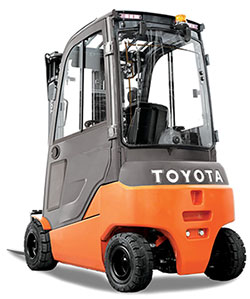ONSITE FORKLIFT PARTS INVENTORY- GOOD OR BAD IDEA?
If you have the space, it could be a money saver.
Onsite forklift parts inventory is an idea worth looking into for companies that are set up to do their own equipment maintenance and/or have a large fleet of equipment that necessitates frequent replacement of forklift parts, or other material handling parts. If you have been thinking about incorporating onsite parts inventory into your business, read on to find out if one of the two key options would work for your business site.
The most common option involves carrying consignment inventory. Consignment inventory is parts inventory that is in the possession of the customer (the onsite business owner), but is still owned by the parts supplier. Essentially, the supplier places some of his inventory in his customer’s possession (in their warehouse) and allows that business to pull as needed directly from this stock. The customer purchases the inventory from the supplier only after he has pulled it for use from his own warehouse. This works out well for businesses that sell a certain brand of forklifts and need to have those parts always readily available, such as Toyota forklift parts, or other specialized parts.
The main benefit to the customer is obvious; he does not have to tie up his capital in inventory. However, he will likely accrue some inventory carrying costs, because he will need to supply and manage a storage area for the parts inventory. Another benefit is the reduction in the customer's downtime, since the necessary forklift parts for repair will be right there, on hand, onsite. That also translates to cost savings for parts usually shipped overnight for down equipment. One of the potential disadvantages is the need to keep the warehouse of consigned forklift parts secure and accurately accounted for. There may necessitate the need for an employee who oversees this area. Typically, companies providing consignment inventories conduct quarterly inspections/inventories so that problems can be detected quickly and potential issues and solutions discussed and implemented. So, there is a shared risk and benefit as the two companies are partners in this particular onsite inventory format.
The second onsite inventory option also involves incorporating a secured area for forklift parts storage but, unlike the consignment option, the business owner would purchase these parts at the time the parts are entered into the storage area. For example, when Toyota forklift parts are needed on the floor, the parts would be pulled out of storage and immediately purchased and receipted. This option has many of the same benefits as consignment inventory: reduced downtime, increased productivity, cost savings due to volume purchases, reduced shipping expenses, etc. An attractive benefit that may make it more suitable than consignment is that the upfront purchase policy eliminates any potential high security concerns. Because this format removes the shared risk with the vendor, the need for onsite vendor-initiated inventory checks are removed or reduced, as inventory management, usage policies, and access are all customer controlled and regulated.
Whichever onsite forklift inventory option you look further into, be sure to obtain answers to the following questions:
- Are both parties clearly understanding and agreeing too the terms?
- What is the time limit (must parts be purchased or returned within specified period)?
- What is the shipping policy?
- What is the return policy?
- Who holds responsibility for damage or loss while in customer’s possession?
- What are the insurance implications?
- Exactly how, when and what data is exchanged?
- How are miscellaneous transactions processed?
- How are cycle count adjustments handled?
- How are customer returns settled (does a return initiate a credit from the supplier)?
- How is scrap addressed?
Finally, it's very important to realize that consignment inventory will almost always add costs to the supply chain. Therefore, you will only want to incorporate that option when you know the benefits will surpass the added costs. That can be determined first by considering what level of importance material handling equipment has in the overall business flow. For many customers, this is related to actual fleet size, seasonality of business, and the average service time for getting down equipment back up and running. You may find that to have your forklift parts, aerial lift parts, payload vehicle parts, etc., readily available for quick installation and repair just might pay for itself over time.

